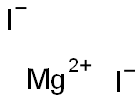
Magnesium iodide
- Product NameMagnesium iodide
- CAS14332-62-8
- MFMgI2
- MW278.11
- EINECS233-825-1
- MOL File14332-62-8.mol
Usage And Synthesis
MgI2·8H2O is a crystalline powder, white and deliquescent,
discoloring in air; soluble in water, alcohol, and
ether. This salt has been used in medicine. The anhydrous
compound has a molecular weight of 278.1139 g/mol,a melting point of 637°C, a density of 4.43 g/cm3 and
a water solubility of 1480 g/l at 18°C. MgI2 has the
same type of structure (CdI2) as the chloride and bromide
except that the cell parameters differ.
Magnesium iodide is stable at high heat under a hydrogen atmosphere, but decomposes in air at normal temperatures, turning brown due to the release of elemental iodine. When heated in air, it decomposes completely to magnesium oxide, releasing iodine vapor. Magnesium iodide is known to form three hydrates, MgI2·6H2O, MgI2·8H2O and MgI2·10H2O of which the decahydrate is claimed to be the most stable.
Magnesium iodide is stable at high heat under a hydrogen atmosphere, but decomposes in air at normal temperatures, turning brown due to the release of elemental iodine. When heated in air, it decomposes completely to magnesium oxide, releasing iodine vapor. Magnesium iodide is known to form three hydrates, MgI2·6H2O, MgI2·8H2O and MgI2·10H2O of which the decahydrate is claimed to be the most stable.
Magnesium iodide has few commercial uses but can
be used to prepare many compounds for organic
synthesis. Usage of magnesium iodide in the “Baylis–
Hillman” reaction (an organic reaction of an aldehyde
and an α,β-unsaturated electron-withdrawing group
catalyzed by MgI2) tends to give vinyl-specific
compounds.
Another example of the usage of MgI2 as a catalyst
involves the reaction of 2,3,4,6-tetra-O-benzyl-D-gluconolactone
or 2,3,4,6-tetra-O-benzyl-D-mannono-lactone
with MgI2 in EtOH which afforded the respective C-2
epimer.
Magnesium iodide is the name for the chemical compounds with the formulas MgI2 and its various hydrates Mgl2(H20)X. lt has few commercial uses, but can be used to prepare compounds for organic synthesis. Magnesium iodide can be produced from magnesium oxide, magnesium hydroxide, and magnesium carbonate by reaction with hydroiodic acid:
MgO+ 2HI →MgI2+ H2O
Mg(OH)2+ 2HI → Mgl2+2H2O
MgCO3+2HI →MgI2+ CO2+ H2O
MgO+ 2HI →MgI2+ H2O
Mg(OH)2+ 2HI → Mgl2+2H2O
MgCO3+2HI →MgI2+ CO2+ H2O
Related Product Information
PROMPT×
PROMPT
The What'sApp is temporarily not supported in mainland China
The What'sApp is temporarily not supported in mainland China
Cancel
Determine